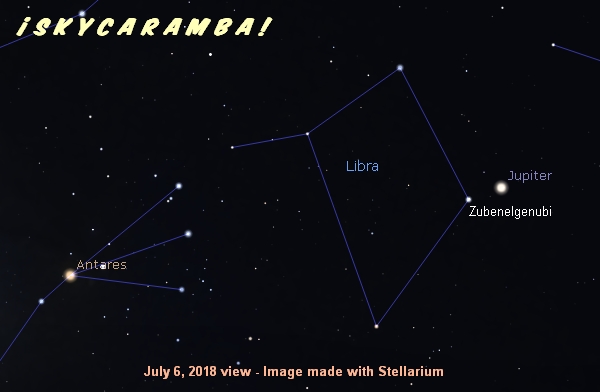In the middle of July, you’ll be able to see all five naked eye planets and the crescent moon in the sky at the same time. Get ready for this wondrous view by identifying and watching them as the month starts.

Mercury is below Venus in the west after sunset. Jupiter is near the meridian. Saturn has risen. Mars will be up mid to late evening. Mercury climbs higher each evening so it sets later until it’s at greatest elongation on the 12th. Meanwhile Mars, heading to opposition on the 27th, is rising earlier. Watch them from night to night until darkness sets in and Mercury and Mars are both still up on opposite sides of the sky with the other planets between them. It’s too bad Uranus is a morning object. It is also possible to see it with the naked eye, but because it’s so dim it’s usually not counted as a naked eye planet.
On the way to this setup, you can see Mercury enter the Beehive Cluster, also known as M44, in Cancer. It’ll be next to the cluster on the 4th and 5th. Then is passes by Asellus Australis, the southern donkey. Because the beehive is sort of between that star and another called Asellus Borealis, the cluster has also been named the manger.
Venus and Mercury seem to be on parallel courses. Venus passes Regulus around the 10th. In case you missed the chance to identify Mercury when it was by the beehive, look for the crescent moon next to it on the 14th. The moon is next to Venus the next night.

Jupiter spends the month nearly stationary near Zubenelgenubi. The moon passes by on the 20th.

Saturn is retrograde all month north of Kaus Borealis and near a star named Polis. The moon passes by on the 24th.

Mars is also retrograde all month. The moon is in the neighborhood on the 27th.
Morning skywatchers will see that Orion has made his appearance, rising just before the sun. Mars is setting.

There is a partial solar eclipse on the 13th. The far southeast Australian continent and Tasmania will get the view along with part of Antarctica and the ocean between them. Also, New Zealand’s Stewart Island will get a brief show.

And there’s a total lunar eclipse on the 27th. Parts of Africa and Asia get to see all of it. For Australia and eastern Asia, the moon is setting during the eclipse. The moon is rising during the eclipse for the rest of Africa, Europe, and most of South America. The moon is at apogee–at the farthest point in its orbit–on the date of the eclipse. So it is moving slowest. And because it’s also moving through the most central part of Earth’s shadow, it will take a long time to get through it. At 1 hour, 43 minutes, this is the longest total lunar eclipse of the moon in the 21st century.
Earth is at aphelion on the 6th. Mercury is at aphelion on the 20th.
